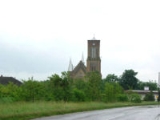
Stari Žednik
Encyclopedia
Stari Žednik also known as Žednik (Жедник), is a village located in the Subotica
municipality, in the North Bačka District
of Serbia
. It is situated in the autonomous province of Vojvodina
. The village is ethnically mixed and, according to the 2002 census, it has 2,230 inhabitants with a Croatian
relative majority.
and Hungarian
.
Subotica
Subotica is a city and municipality in northern Serbia, in the Autonomous Province of Vojvodina...
municipality, in the North Bačka District
North Backa District
North Bačka District is a northern district of Serbia. It lies in the Bačka region in the autonomous province of Vojvodina. It has a population of 200,140...
of Serbia
Serbia
Serbia , officially the Republic of Serbia , is a landlocked country located at the crossroads of Central and Southeast Europe, covering the southern part of the Carpathian basin and the central part of the Balkans...
. It is situated in the autonomous province of Vojvodina
Vojvodina
Vojvodina, officially called Autonomous Province of Vojvodina is an autonomous province of Serbia. Its capital and largest city is Novi Sad...
. The village is ethnically mixed and, according to the 2002 census, it has 2,230 inhabitants with a Croatian
Croats
Croats are a South Slavic ethnic group mostly living in Croatia, Bosnia and Herzegovina and nearby countries. There are around 4 million Croats living inside Croatia and up to 4.5 million throughout the rest of the world. Responding to political, social and economic pressure, many Croats have...
relative majority.
Ethnic groups (2002 census)
- CroatsCroatsCroats are a South Slavic ethnic group mostly living in Croatia, Bosnia and Herzegovina and nearby countries. There are around 4 million Croats living inside Croatia and up to 4.5 million throughout the rest of the world. Responding to political, social and economic pressure, many Croats have...
= 727 (32.60%) - Hungarians = 576 (25.83%)
- BunjevciBunjevciBunjevci are a South Slavic community and ethnic group living mostly in the Bačka region of Serbia and southern Hungary...
= 327 (14.66%) - SerbsSerbsThe Serbs are a South Slavic ethnic group of the Balkans and southern Central Europe. Serbs are located mainly in Serbia, Montenegro and Bosnia and Herzegovina, and form a sizable minority in Croatia, the Republic of Macedonia and Slovenia. Likewise, Serbs are an officially recognized minority in...
= 248 (11.12%) - YugoslavsYugoslavsYugoslavs is a national designation used by a minority of South Slavs across the countries of the former Yugoslavia and in the diaspora...
= 139 (6.23%) - Others (Montenegrins, AlbaniansAlbaniansAlbanians are a nation and ethnic group native to Albania and neighbouring countries. They speak the Albanian language. More than half of all Albanians live in Albania and Kosovo...
, GermansGermansThe Germans are a Germanic ethnic group native to Central Europe. The English term Germans has referred to the German-speaking population of the Holy Roman Empire since the Late Middle Ages....
, MacedoniansMacedonians (ethnic group)The Macedonians also referred to as Macedonian Slavs: "... the term Slavomacedonian was introduced and was accepted by the community itself, which at the time had a much more widespread non-Greek Macedonian ethnic consciousness...
, RusynsPannonian RusynsRusyns in Pannonia, or simply Rusyns or Ruthenians , are a Slavic minority in Serbia and Croatia...
, SlovaksSlovaksThe Slovaks, Slovak people, or Slovakians are a West Slavic people that primarily inhabit Slovakia and speak the Slovak language, which is closely related to the Czech language.Most Slovaks today live within the borders of the independent Slovakia...
, etc).
Tourist attractions
The Saint Mark the Evangelist Catholic Church was built by the plans of Zsigmond Moravetz, in neogothic style and opened in 1911. Its first parish priest was Hungarian Benjamin Hegedűs, and the current one is Croat Željko Šipek, who serves the community in both, CroatianCroatian language
Croatian is the collective name for the standard language and dialects spoken by Croats, principally in Croatia, Bosnia and Herzegovina, the Serbian province of Vojvodina and other neighbouring countries...
and Hungarian
Hungarian language
Hungarian is a Uralic language, part of the Ugric group. With some 14 million speakers, it is one of the most widely spoken non-Indo-European languages in Europe....
.
See also
- List of places in Serbia
- List of cities, towns and villages in Vojvodina

